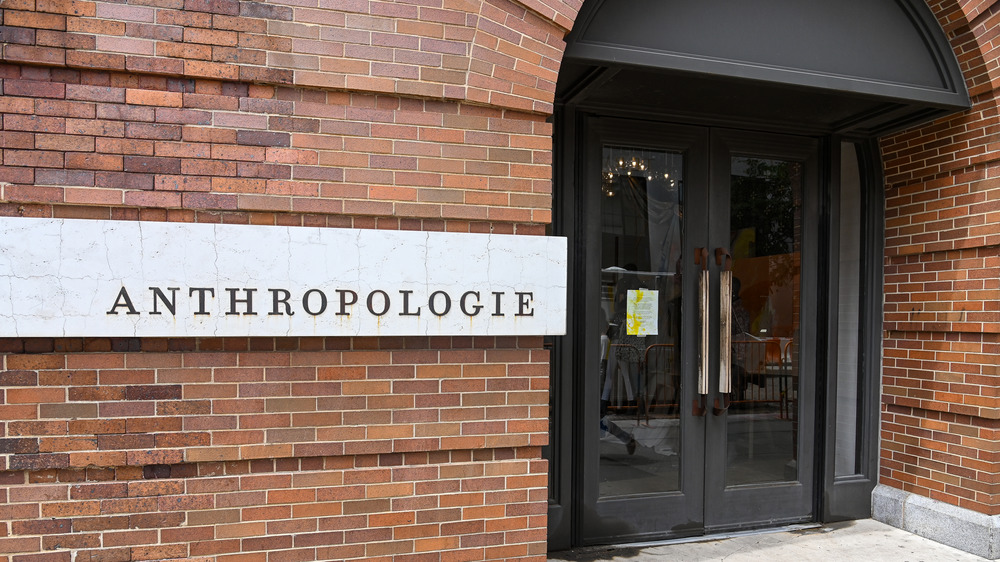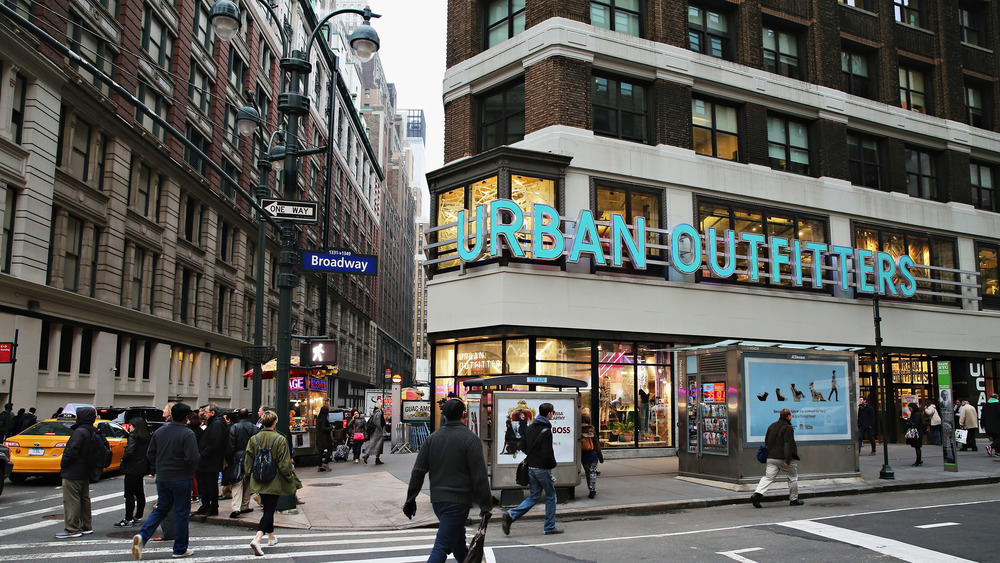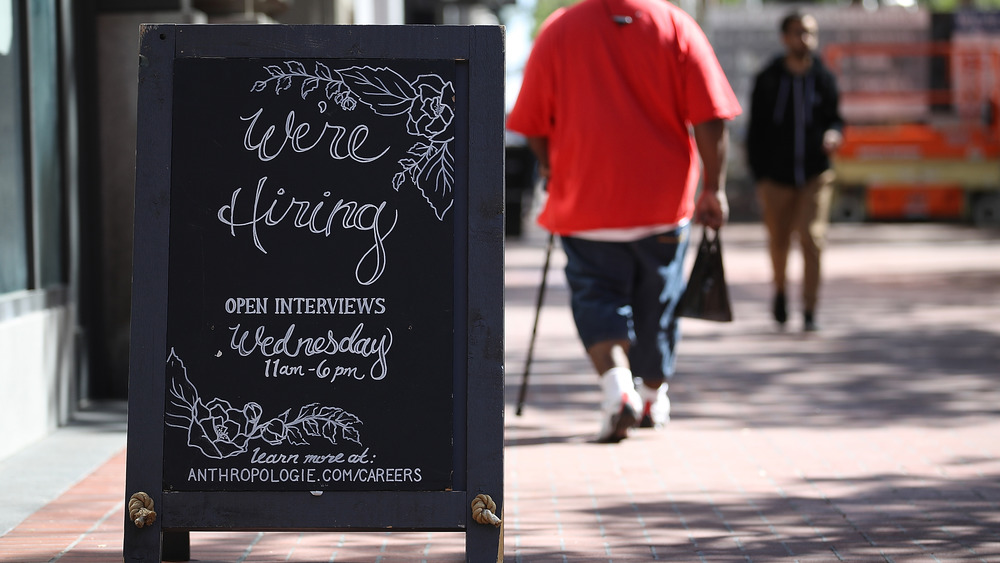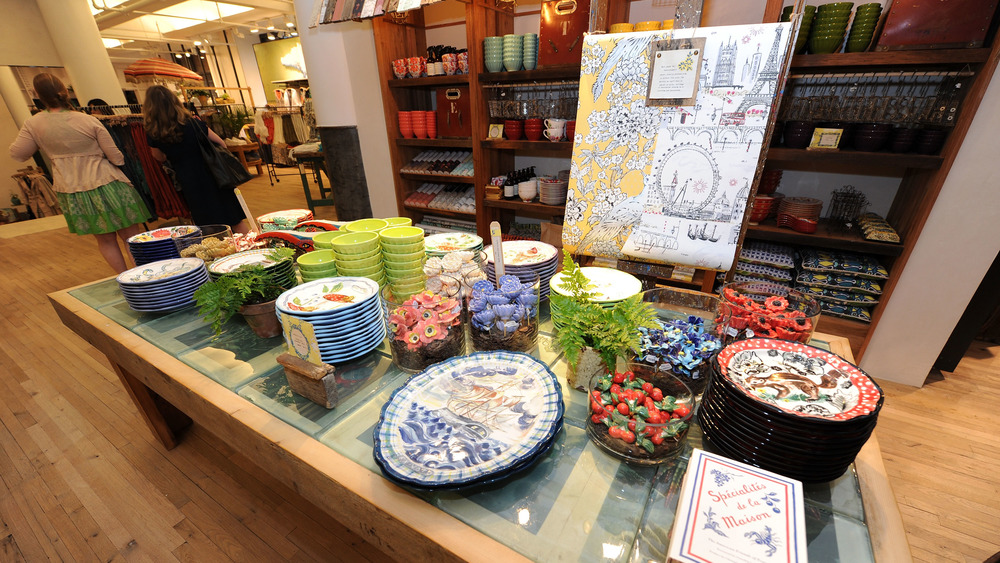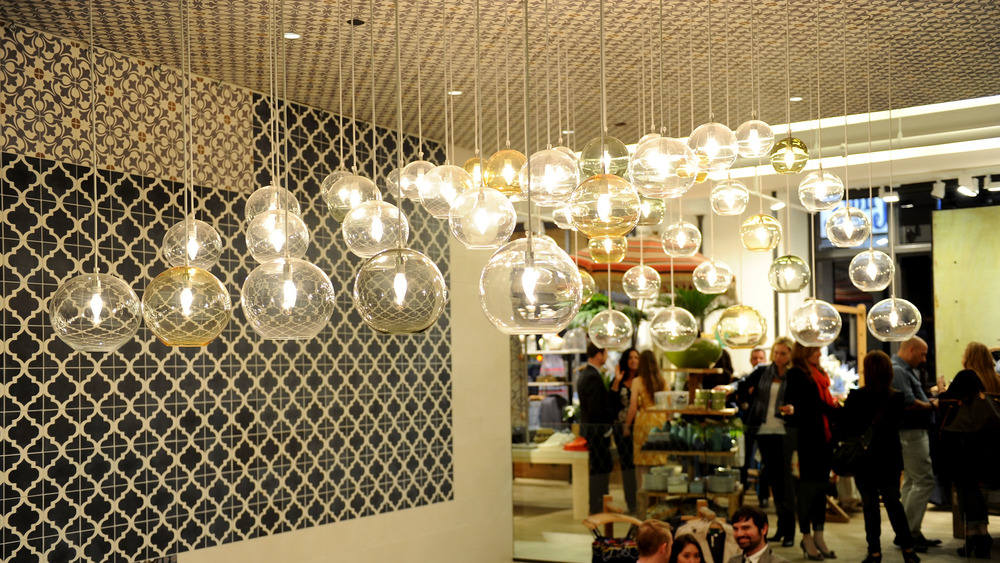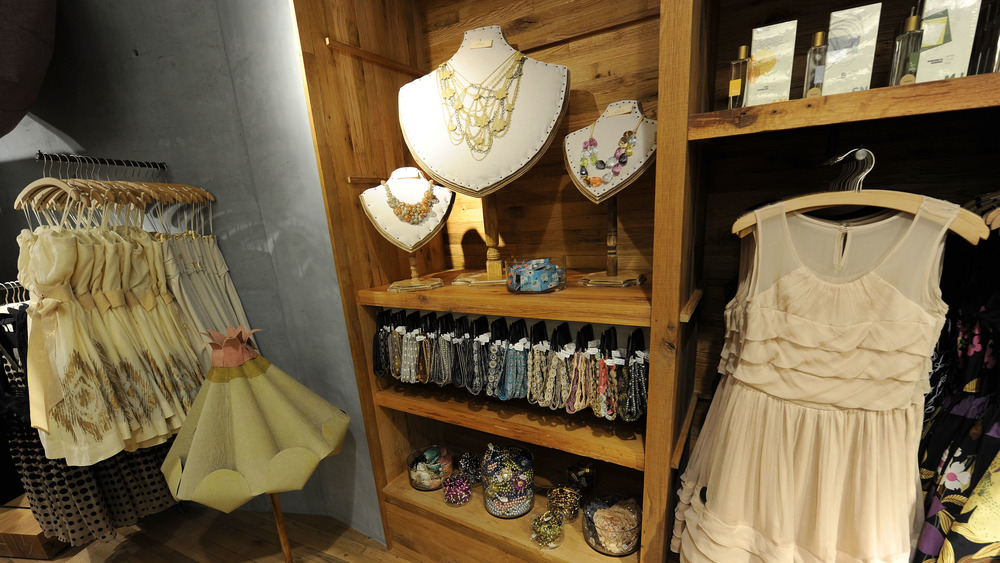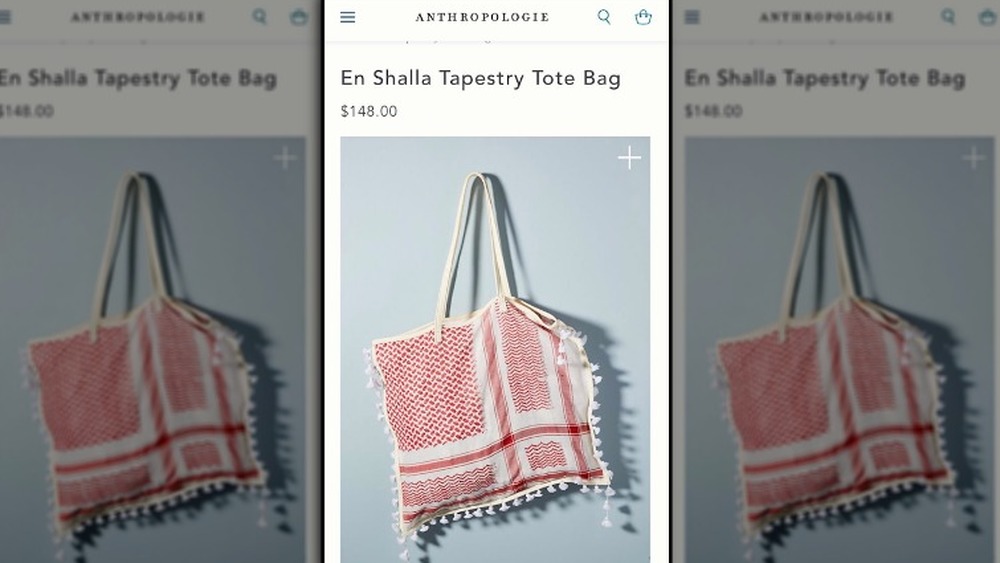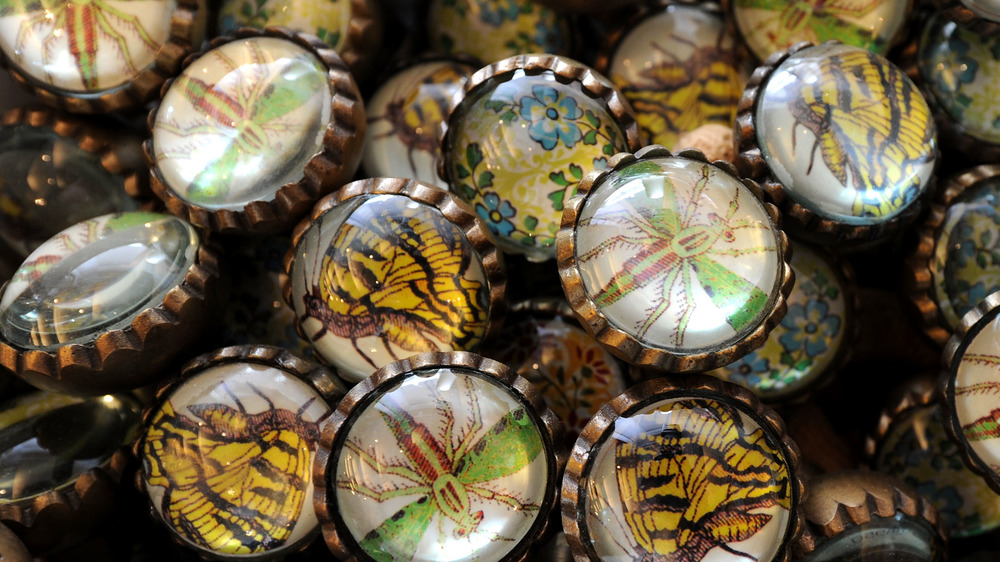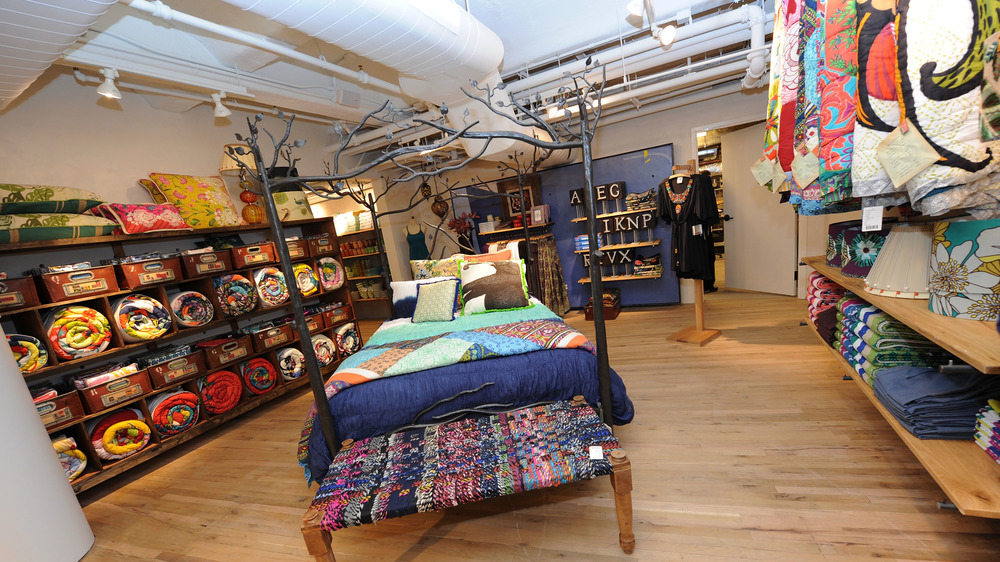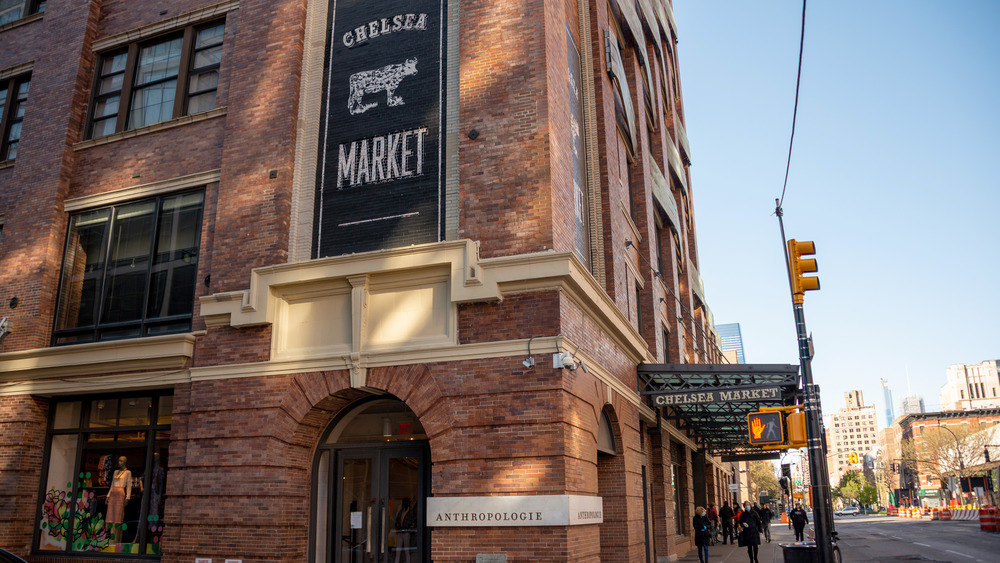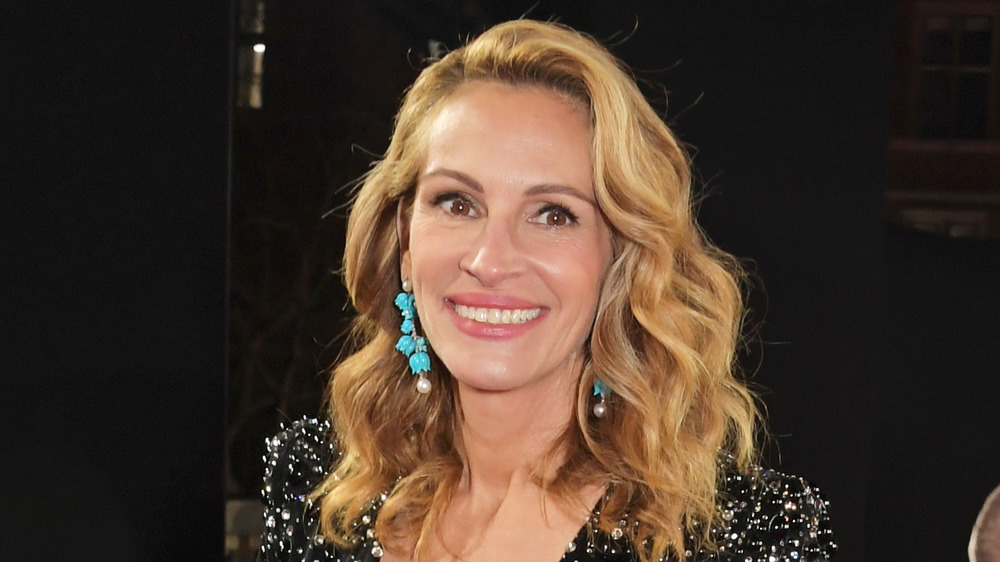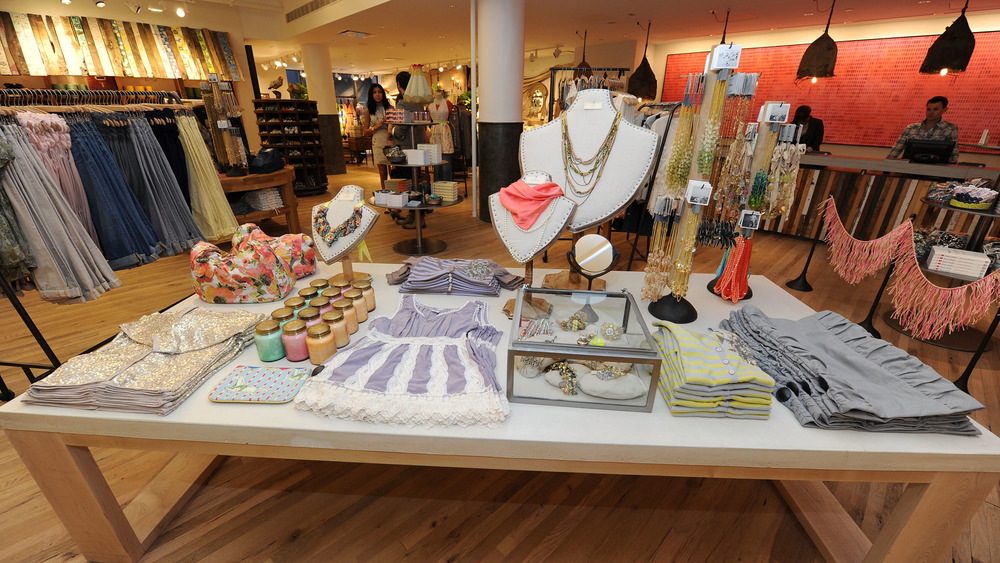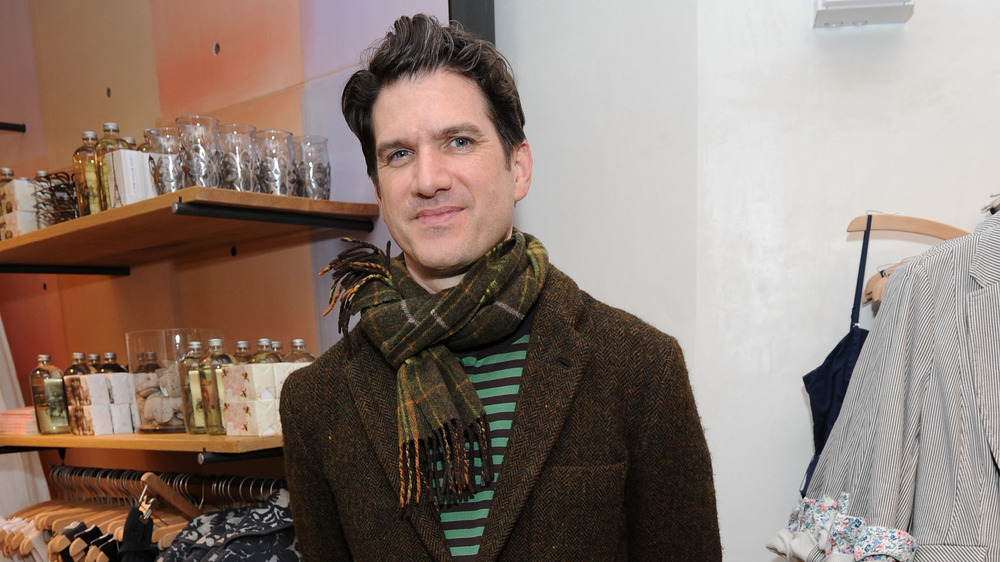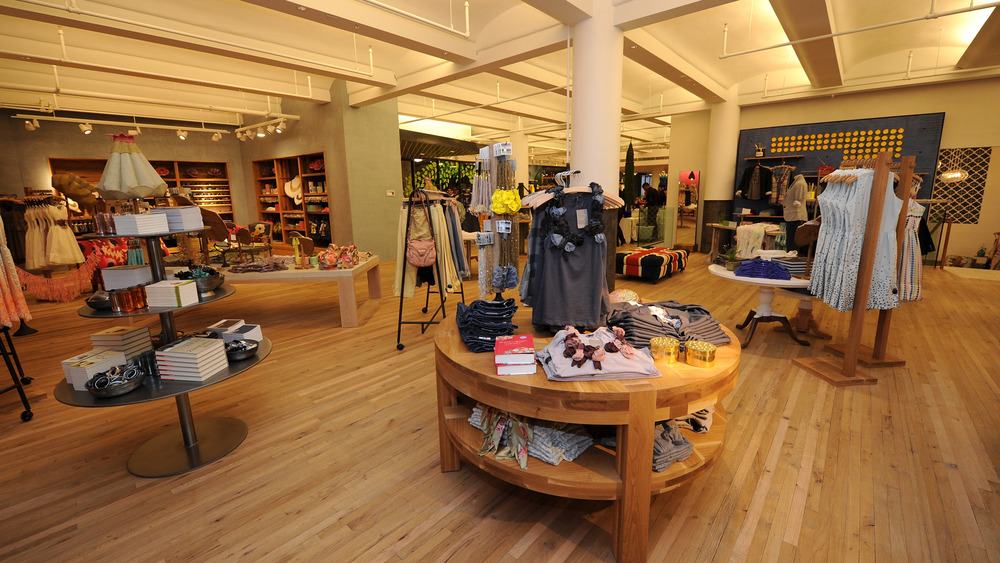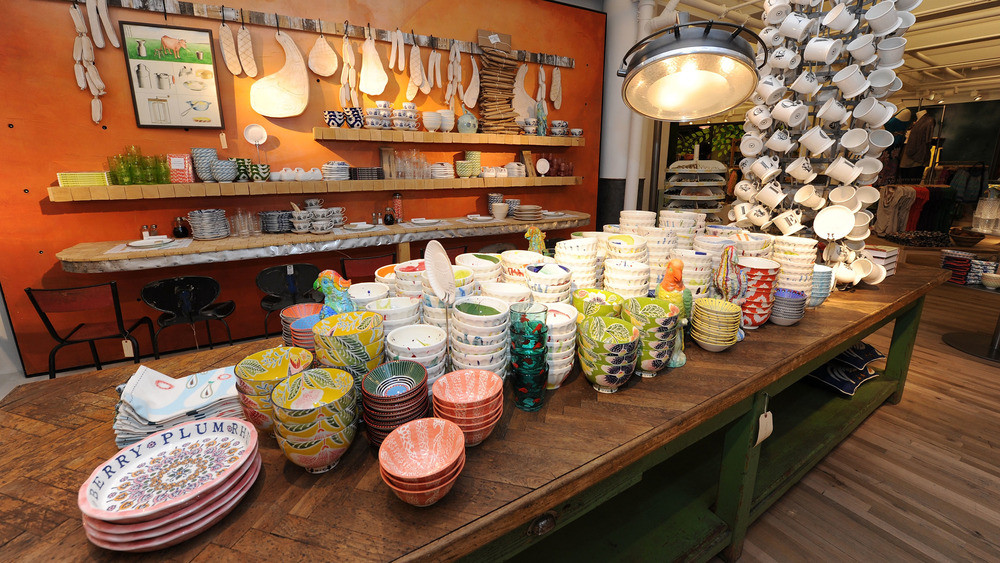The Untold Truth Of Anthropologie
Anthropologie is one of those stores that has a cadre of loyal fans who are super passionate about shopping there (via Fast Company). Whether you're looking for a batik-fabric dress, a gently distressed denim skirt, throw pillows that remind you of your vacation in Bali last year, or bowls and plates with thoughtful handmade touches, Anthropologie probably has it. Or perhaps you yearn for bergamot perfume or a plush silk pillowcase? Anthropologie likely has that too, as they have a beauty and wellness line in addition to their clothing, home decor, furniture, and shoe lines.
If you've ever found yourself sucked into an Anthropologie store only to emerge three hours later with a newly-emptied wallet, you're not alone. In fact, all Anthropologie stores are thoughtfully curated by marketing-savvy minds who want to make you feel like you've been transported into a unique, elegant world — one in which you go shopping with your bestie, Julia Roberts. Yes really.
Curious to learn all that you can about your favorite store? Read on to discover the untold truth of Anthropologie.
Guess what parent company owns Anthropologie?
When you step into an Anthropologie store, you know that's exactly where you are. But if you thought it feels a bit familiar, there's a good reason for that: the parent company of Anthropologie is URBN, the same company that owns and operates Urban Outfitters stores. According to their website, URBN is "a portfolio of global consumer brands comprised of Urban Outfitters, Anthropologie, Free People, BHLDN, Terrain, Menus & Venues, and Nuuly." That explains why you can score chic floral-printed window dressings at either Urban Outfitters or Anthropologie, and have your friends wonder which of the two stores carry them.
The very first store URBN founded was a Free People shop in Philadelphia all the way back in 1970, according to The Washington Post. Described by the newspaper as a "head shop," the store sold a variety of items such as kitschy "ethnic" jewelry, cannabis accessories, housewares, and used clothes — at affordable prices, if you can believe that last bit. Basically, it was a hippie trap, a formula that works for URBN to this day.
Anthropologie's founder traveled for two years conceptualizing the store
After Anthropologie founder Richard Hayne successfully created Urban Outfitters, it was time for him to turn his attention to a new project. Given that he, along with his wife and friends, had "outgrown" Urban Outfitters — which caters to rich college kids — he wanted to create a store for a slightly older demographic.
Hayne didn't go about this task lightly, either. Rather, he secured the help of architect Ron Pompei, who helped helm the creation of both Anthropologie and Urban Outfitters. The pair spent two years on a "cultural odyssey," traveling the world while visiting museums and researching all that they could. "[It] was a return to an earthier sensibility," Pompei explained to Fast Company. "We saw things that were tactile and visceral. Things that engaged the whole body. Texture was very important. Storytelling was central."
At the end of their journey, Pompei and Hayne came up with the concept of Anthropologie, a store that focuses on the customer's identity and not just peddling stuff. "Recently, what you do has become more important," Pompei continued. "We wanted to respond to the shift toward 'who you are.'"
This is why the store is called Anthropologie
Of course, when someone spends two years conceptualizing a store, what they decide to call it is obviously very important. To that end, founder Richard Hayne settled on "Anthropologie," which he clearly felt encompassed everything he wanted to convey.
Wondering just how the name came to be? According to Lehigh Valley Life, Hayne graduated from Lehigh University in 1969. And while you may be tempted to think that he spent his time at the college majoring in business, given his successes in retail, Hayne actually got his degree in anthropology. That perspective informed how he built Anthropologie, which is simply the French version of the word. And the name is fitting, if you think about it; the store definitely conjures imagery of college students discussing cartography while sipping strong, black tea and wearing colorful maxi dresses.
Hayne made the right decision in bestowing a name on Anthropologie, as it went on to make the store a brand beloved by many.
Anthropologie spends a pretty penny on design and decor
If you've ever been inside of an Anthropologie store, you've probably noticed all of the hand-created displays and elegant window dressings. That's in addition to the thoughtful decor and custom lighting, all of which are designed to make you feel a certain kind of way.
All of that is by design, as Anthropologie strives to showcase artisan-crafted displays, says Jill Gallenstein, Anthropologie's eastern regional display manager. "The challenge is to take these relatively cheap, ordinary materials and make them into extraordinary artwork," she explained in an interview with Racked. "This is what makes our store experience: the ordinary to extraordinary, the handmade detail." That's how you get something like a flock of birds sculpted from burlap and gingham, or seashell-covered Christmas trees.
Of course, up-cycling base materials into elegant cabinets and wall hangings isn't going to be cheap. In fact, each season, Anthropologie stores are given up to $5,000 for their window budgets. That's certainly a far cry from the bare warehouse look of stores like Costco and Walmart! But you can't argue that it works and renders Anthropologie a unique brand.
Let's face it: Anthropologie is not a cheap place to shop
One thing that everyone notices about Anthropologie is the fact that it's super expensive to shop there. One quick look at its website, and you can see just how much the brand believes you'll fork out for a tunic style dress made out of velvet or over-the-knee boots crafted from suede and leather.
But shelling out $200 for shoes is just the start of it. According to Racked, Anthropologie's price tags are sometimes stratospheric. Consider the $300 sweaters, or perhaps the $350 pitcher. While you're at it, why not plunk down $3,000 for a copper fire pit? Heck, may as well splurge on that $9,000 camping tent, right? It's "perf for the pool," after all.
That's not to say that the products Anthropologie sells are of a shoddy quality, but not everyone can afford a $3,000 hand-woven rug. It's no wonder that BuzzFeed published an exhaustive list of affordable alternatives. That way you can save your money for taking an actual trip to somewhere other than the inside of an Anthropologie store.
Anthropologie has been accused of cultural appropriation
Given Anthropologie's desire to make you feel like you're going on a journey, it's seems unsurprising that they've been accused of cultural appropriation at least once. Notably, Anthropologie sparked the ire of Twitter in 2018, when it sold a tote bag that looked like it was made out of a Palestinian keffiyeh, which is a symbol of Palestinian resistance. One user wrote that it was "the definition of [f**kery] when a symbol of Palestinian resistance is demonized on the daily." Another explained, "My culture is not your tote bag."
Anthropologie quickly yanked the product off its shelves, and publicly apologized for the mishap. "The tote was sourced from a third-party brand, which designed and manufactured the item," they said in a statement obtained by Teen Vogue. "To address our oversight, we pulled the tote and apologize for any offense it may have created."
The Twittersphere was also upset about the name of the product, which was "En Shalla Tapestry Tote Bag," as "Inshallah" means "God willing" in Arabic. But En Shalla is the name of the brand who made the bag, so that's not Anthropologie's fault. Still, it's not a good look.
Anthropologie wants to "inspire" its shoppers
When you step into an Anthropologie store, do you feel like you've been transported to a far-off place like Zanzibar? Or perhaps you can imagine yourself shopping the market stalls in a Moroccan souq? If so, then Anthropologie has succeeded in its mission, according to corporate creative director Missy Peltz. "We have this romantic notion that people still want to be inspired," she shared in a chat with Racked. "Not only by a garment or gadget, but by an experience or scent. We want to immerse the customer in a complete experience by appealing to all of her senses."
Anthropologie's desire to stimulate you is also coupled with the fact that they want you to interact with the store and the products inside of it. "Our aesthetic is authentic and approachable," Peltz continued. "It is not pristine or precious, which at times can be intimidating." Considering you'd be out of a paycheck if you broke a dish or two, that intimidation is understandable, though.
Three imaginary women are the backbone of Anthropologie
In order to appeal to a wide variety of customers, Anthropologie has developed a slick marketing strategy, which simultaneously allows each store to flex their creative muscles while remaining on brand. Each season, corporate dreams up three separate profiles of imaginary Anthropologie shoppers, as noted by Racked.
For example, during the 2014 holiday season, the three women were named "Aurora," "Silver," and "Quinn." Aurora was conceived as a holiday lover with a liking for shiny things, whereas Silver is a "ranch girl" who loves "sunset tones" and probably wears a lot of bulky sweaters. And finally, Quinn is a "city girl" who is more "pulled together [and] buttoned-up" than her imaginary peers; that's why you'd find her at the back of the store.
Once corporate hands these profiles down to each individual store, staff can merchandise their floor how they see fit, as long as the concepts are adhered to.
You'll likely find Anthropologie in old buildings
It's clearly evident that Anthropologie is hyper-focused on the customer experience, and that they very much want you to spend time in their stores. That's why you're more likely to find an Anthropologie in a historic building instead of at the mall, according to former Executive Creative Director Kristin Norris. "Our visual philosophy is to make the store feel as if it's a one-off, to feel like it's the only one," she explained to SFGate. "We capitalize on existing architectural elements." She added that every store is similar to each other, but none of them are precisely the same, like The Gap or Abercrombie & Fitch might be.
Additionally, Anthropologie is sensitive to regional differences, which can play a factor in what a customer wants to purchase. "We want each store to have a unique personality and cater to the customer," Norris continued. "The customer in Miami is not the customer in Seattle." She does have a point, to be honest.
If Anthropologie had a celeb spokeswoman, it would be Julia Roberts
Plenty of brands utilize celebrity spokespeople in order to better sell their products. For example, Silk teamed up with Michael Phelps for a commercial, and both Jennifer Aniston and Gal Gadot have been the face of Smartwater, as noted by Today. Clearly the formula works, as celebs are often paid very well for these brand partnerships.
While Anthropologie doesn't have an official celebrity spokesperson, Julia Roberts is the "celebrity avatar" of the brand, according to Fast Company. So next time you're browsing through some ceramic serving dishes or trying on a pleated sheath dress, pretend you're at Roberts' house and see how it tracks.
As it turns out, Roberts herself is a fan of Anthropologie, and she shops there on the reg, as do Madonna, Sharon Stone, and Susan Sarandon. And remember Roberts' work in the 2001 film The Mexican? Her costumes in the movie are literally from Anthropologie.
This is why you've never seen a commercial for Anthropologie
Have you ever seen a commercial for Anthropologie on television? Or when flipping through an issue of Vogue or Cosmopolitan, have you stumbled across their advertisements? Of course, the answer is no, because Anthropologie doesn't advertise. It's just not something they need to rely on. "We believe that by starting a conversation and interacting directly with our customers ... we are more effective at understanding and serving their fashion needs," the company wrote in its April 2015 SEC filings.
Additionally, Anthropologie feels that their blogs do the work that traditional advertising does for other companies. "Not only do our blogs allow us to communicate what inspires us, they allow our customers to tell us what inspires them," they continued.
Anthropologie also sends out emails, posts on social media, and relies on its window displays to draw shoppers in. They also publish an old-school catalog, though they don't refer to it that way, according to Susy Korb, chief marketing officer of Anthropologie. "We don't call it a catalog," she revealed in a chat with The New York Times. "We call it a journal." Of course they do.
Believe it or not, but Anthropologie used to sell men's clothes
When you think of Anthropologie, the energy that you summon is definitely feminine. While not everything in the store is gendered, like glazed pottery or painted shower curtains, dresses, skirts, perfumes, lingerie, makeup, skincare, and hair care products are sold in abundance. And, of course, the entire interior of the store is marketed towards women.
Believe it or not, though, Anthropologie used to sell a line of men's clothing back in the day. However, and perhaps unsurprisingly, the line didn't sell well, and Anthropologie founder Richard Hayne had a theory for why. "For a suburban man aged 30 to 40, hell is going clothing shopping on a Saturday afternoon," he explained to Philadelphia Weekly in 2003 (via Mental Floss). "There are about 5000 other things they would put on the list ahead of clothes shopping." Say what you will, but homeboy knows his demographic.
Anthropologie was a hugely profitable brand for a long time
For a long time, Anthropologie was an insanely profitable enterprise. According to Racked, of all of URBN's brands (per its 2014 annual report), Anthropologie had the strongest sales; it accounted for 39 percent of the parent company's total profits, earning a cool $3 billion. That's a lot of money!
However, Anthropologie ran into a little bit of trouble the following year, as noted by the Chicago Tribune. That's when Anthropologie went into a bit of a slump, reporting decreased profits for at least six consecutive quarters. To that end, Richard Hayne steered the brand into a restructuring plan after some staffing changes. "Clearly, the task at hand for the Anthropologie team is to improve the apparel assortment," he told investors.
While Anthropologie appears to have weathered any financial storms, it was impacted by the 2020 "retail apocalypse," as they had to temporarily close certain locations at various points (via their website). As to what the future holds? That's anyone's guess.
Did Anthropologie have a racist store policy?
While Anthropologie is generally an enjoyable place to shop, that doesn't mean it's without its controversies. In addition to cultural appropriation, Anthropologie has also been accused of having racist store policies, as noted by USA Today. The whole thing blew up on social media, after Anthropologie made a post in support of Black lives on their Instagram page. In the snap, the company stated that it will do more for Black communities and organizations, diversify their workforce, and implement anti-racist training. Sounds nice, right?
What Anthropologie might not have expected was the backlash they received in the comments, as many users chimed in to call Anthropologie out on a racist store policy. Allegedly, they used to refer to customers of color as "Nick," and surveil them more than their white counterparts, according to the Daily Mail. Other complaints followed from a variety of disgruntled shoppers.
Anthropologie denied the allegations in a subsequent Instagram post, and again promised that it would do better going forward.

